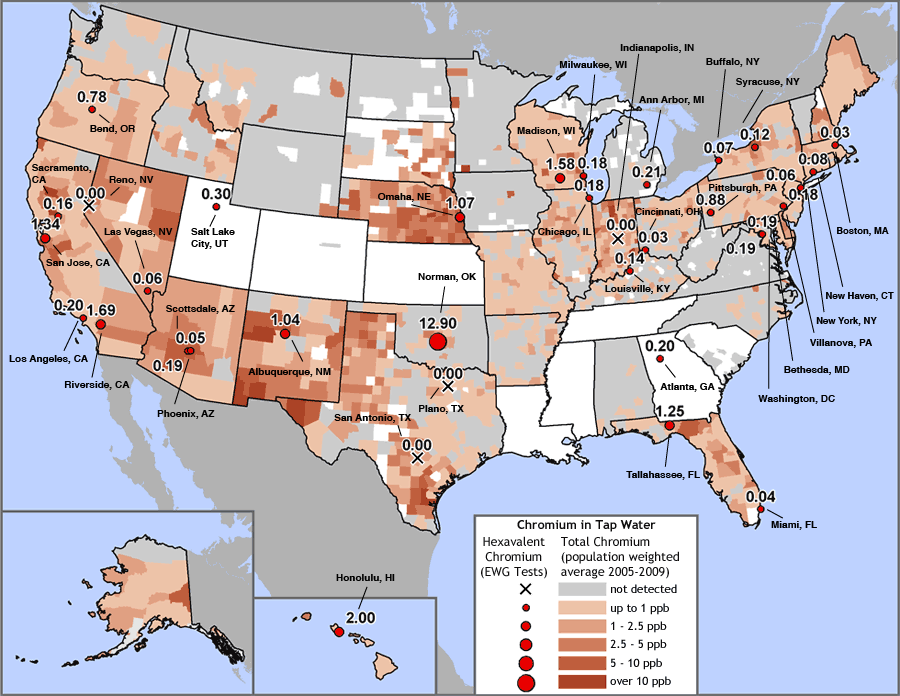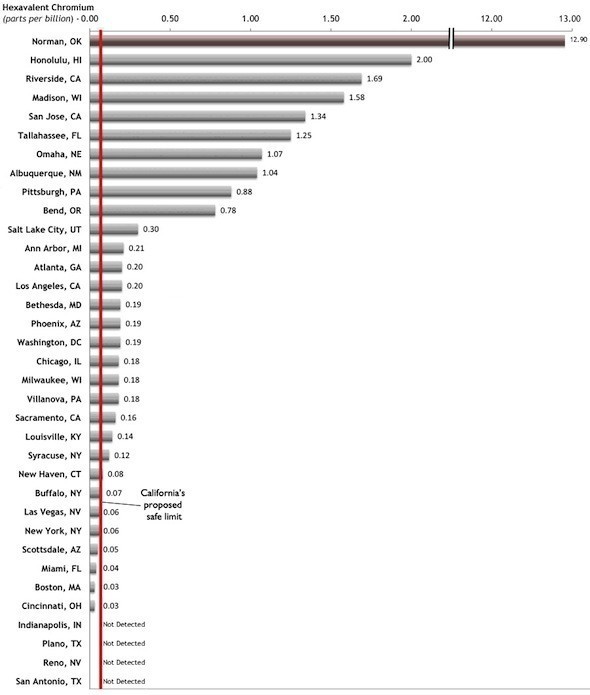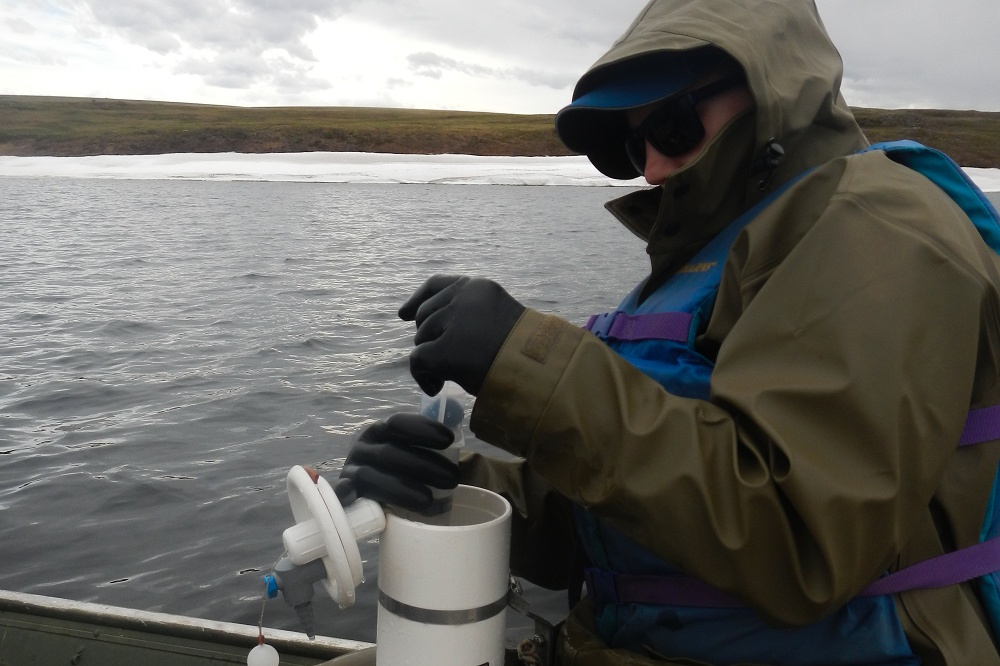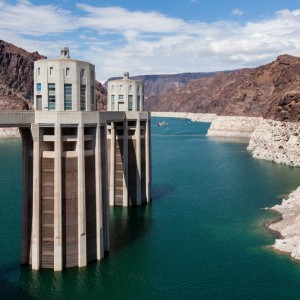Study: Unregulated Toxin Present in Tap Water of 31 U.S. Cities
California is the first state to consider a limit on the “Erin Brockovich” chemical, which has been found in 31 of 35 U.S. cities recently surveyed.

The tap water in many U.S. metropolitan areas was found to have higher-than-recommended levels of chromium-6, a known carcinogenic compound that is not regulated by any state or national agency, according to a study released this week by a public health research and lobbying organization.
The Environmental Working Group (EWG) estimated that 74 million Americans in 42 states drink chromium-polluted tap water, much of which is likely the cancer-causing chromium-6 form.
Chromium-6 comes from industrial processes used to manufacture pigments, dyes and chrome plating, in addition to commonly being discharged from steel and pulp mills. It is also used to tan leather and prevent corrosion.
The compound, also known as hexavalent chromium, is best known from the 2000 biographical film Erin Brockovich, starring Julia Roberts.
Brockovich helped to wage a class-action lawsuit against Pacific Gas & Electric Company for contaminating groundwater in Hinkley, California. The company had hired consultants to produce sham research to obscure the link between the chromium-6 and elevated cancer rates, but, in the end, the residents of Hinkley—where chromium-6 concentrations reached as high as 580 parts per billion (ppb), with natural background levels of 1.19 to 3.09 ppb—were awarded a $333 million settlement in 1996.

More recently, EWG commissioned laboratory tests of tap water from 35 U.S. cities, where previous testing by local utilities had shown high levels of “total chromium,” a measure that includes chromium-3, an essential nutrient for human glucose metabolism.
The average chromium-6 level of all 35 cities was 0.18 ppb, with samples from the city of Norman, Oklahoma registering the highest at 12.9 ppb. One part per billion is the equivalent of one faucet drip of pollutant in 66,000 gallons. Tests detected chromium-6 in samples from 31 cities, and 25 cities showed the toxic metal at concentrations above a 0.06 ppb limit being considered by regulators in California — the only state to require chromium testing.
The compound was undetected in:
- Indianapolis, Indiana
- San Antonio, Texas
- Plano, Texas
- Reno, Nevada

The U.S. Environmental Protection Agency does not regulate chromium-6 specifically, although it has set a total chromium threshold of 100 ppb to protect against skin irritation. EWG argues that it does not make sense to consider a toxic compound together with a beneficial nutrient, specifically chromium-3.
As a step toward a national chromium-6 standard, the EPA released a draft assessment of the compound in September of this year, presenting evidence linking over-exposure to higher cancer rates in humans. The EPA will determine if a new level needs to be set after a final review sometime next year.
In a 2008 study, the National Toxicology Program found that chromium-6 increased the risk of cancer in laboratory animals, including gastrointestinal tumors.
The debate now centers on whether chromium-6 is as toxic in water as it is in the air. There isn’t a lot of data on swallowing the compound, although it is known to cause cancer if it is inhaled.
The American Chemistry Council and the American Water Works Association are urging the EPA to hold off on setting rules until an industry-funded study is published next year, according to the New York Times.
Source: Environmental Working Group, New York Times
Read more: State Water Resources Control Board: Frequently Asked Questions About PG&E’s Background Chromium Study in Hinkley,
Information on Chromium from Apple Valley Ranchos Water Company
Brett writes about agriculture, energy, infrastructure, and the politics and economics of water in the United States. He also writes the Federal Water Tap, Circle of Blue’s weekly digest of U.S. government water news. He is the winner of two Society of Environmental Journalists reporting awards, one of the top honors in American environmental journalism: first place for explanatory reporting for a series on septic system pollution in the United States(2016) and third place for beat reporting in a small market (2014). He received the Sierra Club’s Distinguished Service Award in 2018. Brett lives in Seattle, where he hikes the mountains and bakes pies. Contact Brett Walton









I’m not sure I understand the numbers here, but am I wrong to think that this is surprisingly good news? If natural background concentrations are between 1.09-3.09 ppb, then only 6 of the 35 cities have concentrations as high as the low end of the natural interval, and only one city has concentrations exceeding those at the high end of the natural interval. Even in that one case, which surpassed all of the other samples by a factor of 6, the concentrations were just 2% of those present in the Brockovich case. Perhaps most remarkably, 4 of the 35 cities surveyed had no chromium-6 in their drinking water whatsoever. This all sounds like a pleasant surprise regarding an unregulated and partly naturally-occurring chemical, not a reason for widespread concern.
While it’s certainly nice to see action being taken to reduce exposure to carcinogens in drinking water, it’s not easy to see a case here for prioritizing this policy. If you guys respond to comments, could you possibly say more about why this is worth pursuing?
Hinkley has higher levels of naturally-occurring chromium-6 than most areas, but that does not mean the compound is safe at those concentrations. Arsenic is another natural element that is toxic at high levels.
There is still debate about the effect of ingested chromium-6 on human cancer rates. A 20-year study of Hinkley residents that came out this week suggests that cancer incidence is lower than what would be expected given the community’s characteristics.
Whether a city should test for chromium-6 and hold it under a certain threshold is a matter of preference, acceptable risk and cost-benefit analysis. Testing and removal would be more cost-efficient for a large water supply system, while a small community may decide that the cost is too much for the evident risk. Of course, if it becomes nationally mandated by EPA, then preference becomes moot.
Thanks for the response! That definitely helps to put things in perspective :)
@brett
“Arsenic is another natural element that is toxic at high levels.”
Arsenic and chromium are both toxic at relatively low levels as indicated by the proposed 0.06 ppb in California. However, much of the debate gets lost in determining the actual amount that is ‘legal’.
The real findings here indicate that industrial manufacturing processes pose an inherent risk to our surface and groundwater resources. It is imperative that we oppose any releases to these public trusts from private enterprise.
Industrial waste needs to be processed and treated in a manner that adheres to this ideal, not simply diluted to the point below detection. Many of these heavy metals bioaccumulate and although the water supply may ‘only’ contain 1 ppb, the daily consumption of water from this source can lead to much greater amounts in our bodies over time.
Underground Injection wells for industrial waste frighten me in a way that few other industry practices can. The assumption that there are perfect underground formations for holding industrial waste in a manner that ensures it does not contaminate nearby aquifers, is surely false.